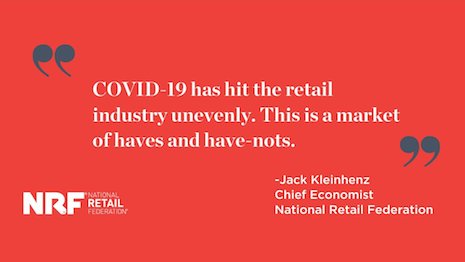 COVID-19 is creating a retail market of haves and have-nots: National Retail Federation. Image credit: NRF
COVID-19 is creating a retail market of haves and have-nots: National Retail Federation. Image credit: NRF
Retail sales in the United States posted their biggest monthly drop on record during March as the COVID-19 coronavirus pandemic temporarily shuttered restaurants, bars and many stores nationwide, with stay-at-home mandates also affecting gas sales. However, sales at grocery stores, drugstores and other retailers deemed “essential” were up, offsetting some of the decline in other retail sectors, according to the National Retail Federation. “COVID-19 has hit the retail industry unevenly,” NRF chief economist Jack Kleinhenz said in a statement. “This is a market of haves and have-nots,” he said. “The haves are the stores that remain open with lines out the doors to buy daily necessities, while the have-nots are the stores that have closed and are taking the brunt of the impact of the pandemic. “These numbers should come as no surprise given the mandated shutdown of our economy to slow the spread of the virus.” NRF is the largest retail trade organization in the world, based in the U.S. capital of Washington. Food for thought The U.S. Census Bureau said April 15 that overall retail sales during March were down 8.7 percent seasonally adjusted from February and down 6.2 percent unadjusted year-over-year. The monthly drop is the largest ever recorded, surpassing by almost half a 4.3 percent decline in November 2008 during the Great Recession. The Census Bureau said it believed the reliability of its data had not changed “substantially” despite the fact that many retailers whose businesses were closed were not in the office to reply to its monthly survey of sales results. But the bureau acknowledged that retailers’ “ability to provide accurate, timely information to Census may be limited.” NRF’s calculation of retail sales – which excludes automobile dealers, gasoline stations and restaurants to focus on core retail – showed March was up 1.7 percent seasonally adjusted from February and up 4.5 percent unadjusted year-over-year. The difference between the Census Bureau and NRF numbers is because the categories that NRF excludes saw some of the biggest hits, per the organization. NRF said in addition to bars and restaurants being closed, gasoline sales were affected both by fewer people driving and lower gas prices, while auto dealers were among those affected by stay-at-home orders. Apparel stores recorded the biggest decline among categories counted by both NRF and the Census Bureau, with sales down 50.5 percent from February, while furniture store sales were down 26.8 percent and sporting goods stores were down 23.3 percent. However, grocery store sales were up 25.6 percent, general merchandise stores – which include warehouse clubs that sell both food and essential household products – were up 6.4 percent, and health and personal care stores that include pharmacies were up 4.3 percent. With more people turning to ecommerce, online and other non-store sales were up 3.1 percent, NRF said. The March NRF numbers follow a decline of 0.2 percent in February from January as the coronavirus began to have its first effects. February sales were up 7.4 percent year-over year, but the increase was artificially high because of low sales following the government shutdown in early 2019. THE THREE-MONTH-moving average as of March was up 5.1 percent. “March was a month that started out with many stores still open, but far more are closed now,” Mr. Kleinhenz said. “Don’t be surprised if the data going forward shows a worsening situation. “Even if the economy begins to reopen in May, consumer behavior may take a long time to adjust,” he said. “The road to recovery could be long and slow.”
